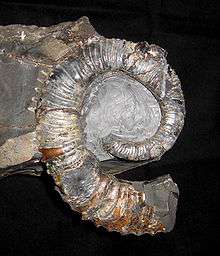Exiteloceras
| Exiteloceras Temporal range: Campanian–Maastrichtian[1] | |
|---|---|
 | |
| Fossil specimen of Exiteloceras jenneyi | |
| Scientific classification | |
| Kingdom: | Animalia |
| Phylum: | Mollusca |
| Class: | Cephalopoda |
| Subclass: | Ammonoidea |
| Order: | Ammonitida |
| Suborder: | Ancyloceratina |
| Superfamily: | Turrilitoidea |
| Family: | Nostoceratidae |
| Genus: | Exiteloceras Hyatt, 1894 |
| Species [2] | |
| |
Exiteloceras is an ammonite genus from the Late Cretaceous.[1]
Exiteloceras was proposed by Alpheus Hyatt in 1894 for heteromorph ammonites with shells that are loosely coiled in a plane, early whorls varying from straight limbs connected by semicircular elbows to elliptical or nearly circular loops, later whorls being elliptical to circular. The whorl section is ovate with the dorsum on the inside curve broader than the venter on the outside. The ribs may be straight or flexuous and mostly slant. Most end with a tubule on the ventrolateral shoulder. The suture is ammonitic. The deeply incised sutural elements are asymmetric, including the double-pronged ventral lobe.
Distribution
Cretaceous of Egypt, Iraq, California, Colorado, Delaware, Montana, New Mexico, Wyoming. [2]
References
- Notes
- 1 2 Sepkoski, Jack (2002). "Sepkoski's Online Genus Database". Retrieved 2014-05-28.
- 1 2 "Paleobiology Database - Exiteloceras". Retrieved 2014-05-28.
- Bibliography
- A Pictorial Guide to Fossils by Gerard Ramon Case
- Arkell, W.J.; Kummel, B.; Wright, C.W. (1957). Mesozoic Ammonoidea. Treatise on Invertebrate Paleontology, Part L, Mollusca 4. Lawrence, Kansas: Geological Society of America and University of Kansas Press.
- Cobban, William A.,1974. Ammonites from the Navesink Formation at Atlantic Highlands, New Jersey; USGS Prof Paper 845.